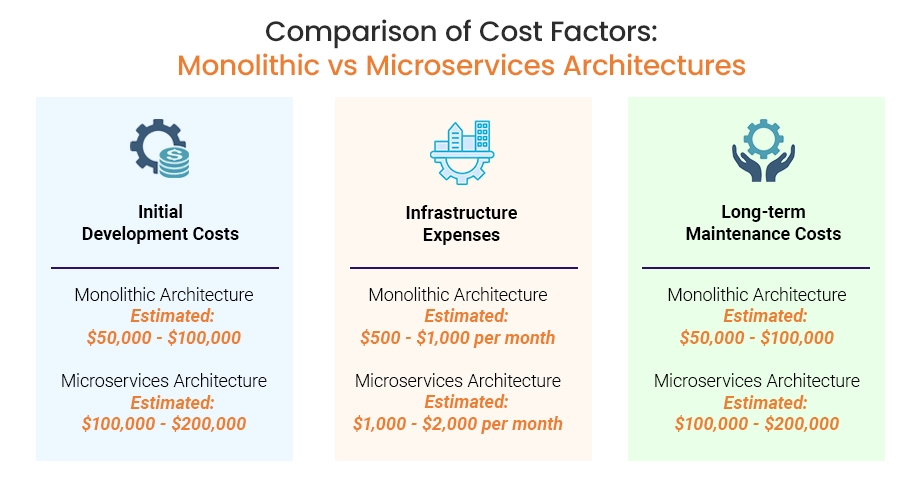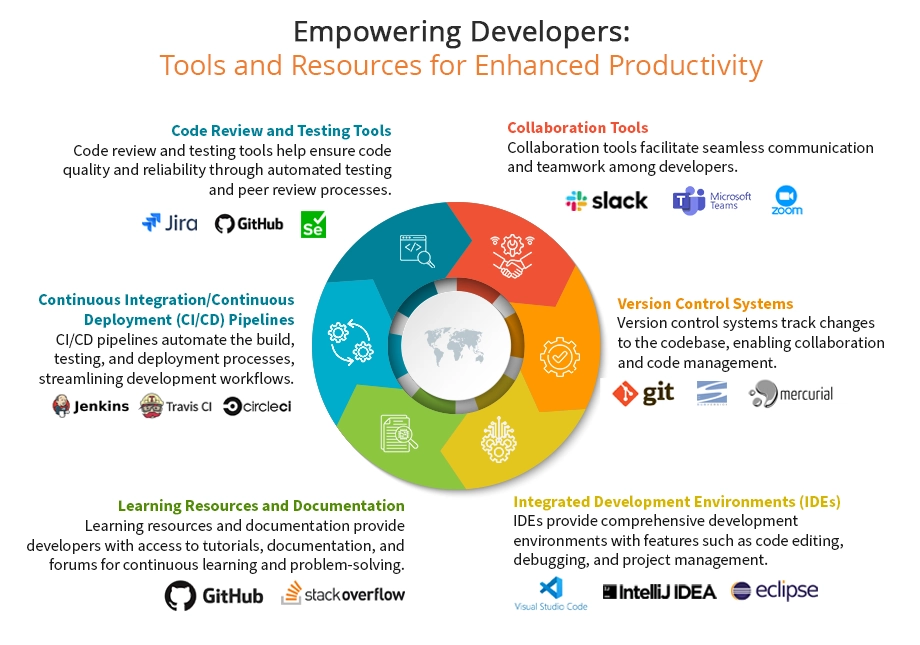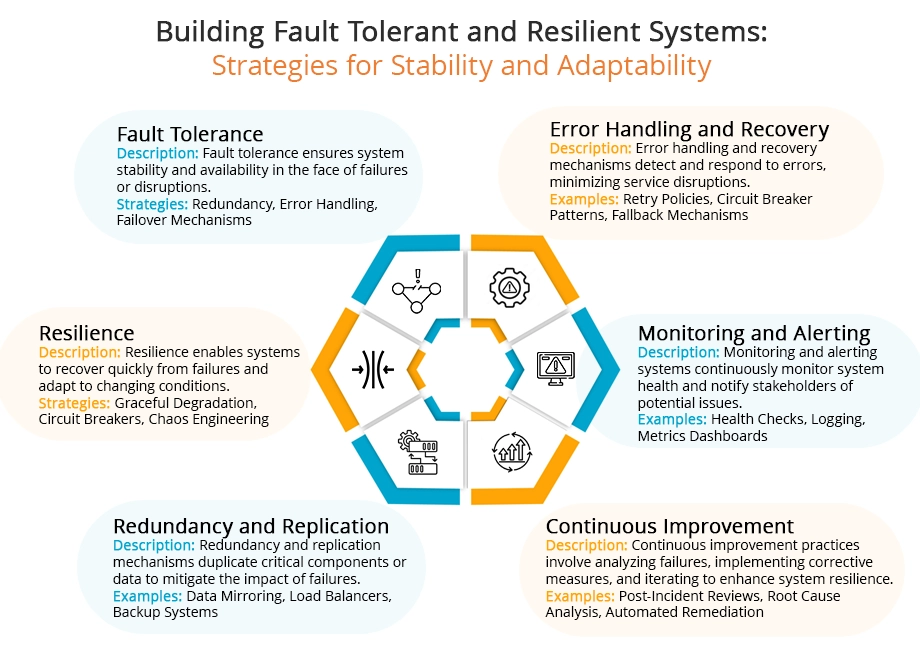Table of Contents
In the realm of software architecture, the discussion between monolithic and microservices architectures remains a topic of intense conversation among to hire software developers, architects, and IT leaders. As organizations strive to construct versatile, strong, and adaptable software solutions, the decision between monolithic and microservices architectures holds significant ramifications for the achievement and longevity of software development projects. This article dives into the complexities of Monolithic vs Microservices architectures, investigating their separate assets, shortcomings, and suitability for various software development situations.
Facts and Data
- As per a study directed by DZone, more than 70% of respondents detailed involving microservices architecture in their projects, mirroring the developing reception and popularity of this architectural approach.
- The Territory of Microservices 2023 report uncovered that 91% of organizations reviewed had embraced microservices architecture somewhat, citing benefits like superior scalability, agility, and faster time-to-market for software applications.
- On the other hand, monolithic architectures remain common in heritage systems and traditional enterprise environments, with laid-out structures and best practices that have stood by everyday hardship.
In the pursuit of modern software development practices, the decision between monolithic and microservices architectures addresses an essential choice that shapes the design, execution, and advancement of software systems. The choice between monolithic vs microservices architecture depends on different factors, including the idea of the application, business prerequisites, specialized constraints, and organizational maturity.
While monolithic architectures give simplicity and familiarity, microservices architectures offer flexibility and resilience in powerful and quickly developing environments. As software development practices keep on advancing, the mission for the ideal architecture remains a continuous excursion of exploration, experimentation, and adaptation to changing prerequisites and arising advancements.
Understanding Monolithic Architecture
Monolithic architecture is a traditional software design approach where all parts of an application are tightly incorporated into a single executable or codebase. According to a survey by O’Reilly, approximately 35% of respondents reported using a monolithic architecture for their applications. In a monolithic architecture, the whole application is deployed as a single unit, with all its functionality and services packaged together. Here is a more profound clarification of monolithic architecture:
- Single Deployment Unit
In a monolithic architecture, the whole application, including its user interface, logic, and data access layers, is bundled and deployed as a single unit. This works on deployment and management, as there’s just a single relic to deploy and maintain for many fintech software development company.
- Tight Coupling
Monolithic architectures commonly exhibit tight coupling between parts, implying that changes to one piece of the application might expect adjustments to different parts. This can prompt difficulties in maintenance, scalability, and extensibility as the application fills in size and complexity.
Make Informed Decisions. Contact Us for Expert Guidance on Monolithic vs Microservices Solutions
Understanding Microservices Architecture
Microservices architecture is an approach to designing and building software applications as an assortment of little, free services that are loosely coupled and autonomously deployable. The adoption of microservices is on the rise, with around 45% of organizations surveyed by NGINX stating they have adopted microservices architectures. Dissimilar to monolithic architectures where all parts are tightly coordinated into a single unit, microservices architectures break down applications into more modest, particular services that impart using distinct APIs. Here is a more profound clarification of microservices architecture:
- Service Decomposition
In a microservices architecture, applications are decayed into various services, each liable for a particular business capability or capability. These services are little, engaged, and freely deployable, permitting developers to execute, deploy, and scale each service independently.
- Loose Coupling
Microservices architectures advance loose coupling between services, implying that each service works autonomously and doesn’t depend on the interior execution details of different services. Micro-services architecture speaks with one another through obvious APIs, like RESTful endpoints or messaging queues, empowering decoupled and asynchronous communication.

Pros and Cons of Monolithic Architecture
Monolithic architecture, a traditional software design approach, has long been a cornerstone in the development of various applications. In this architectural style, all components of the application are tightly integrated into a single, cohesive unit. While monolithic architecture offers simplicity and familiarity, digital transformation in healthcare also presents distinct advantages and disadvantages that organizations must carefully weigh. This introduction sets the stage for exploring the pros and cons of monolithic architecture, shedding light on its strengths and limitations in the context of modern software development practices.
Pros of Monolithic Architecture
In this segment, we investigate the pros and cons of monolithic architecture, looking at its assets and the limitations of modern software development practices for healthcare software development companies.
1. Simplicity
Monolithic architectures are easier to create, deploy, and maintain contrasted with distributed architectures like microservices. With all parts packaged together, developers have a single codebase to work with, making it easier to understand, debug, and deploy applications.
2. Performance
Monolithic architectures can offer better performance in certain situations due to decreased overhead connected with service communication and organization dormancy. Since all parts run within a similar interaction, capability calls and data access tasks are commonly faster contrasted with distributed architectures.
3. Easier Development
Monolithic architectures work on the development interaction by giving a bound-together development climate and toolset. Developers can work cooperatively on various parts of the application without agonizing over cross-service dependencies or versioning issues.
Cons of Monolithic Architecture
1. Limited Scalability
Monolithic architectures can be trying to scale on a level plane, particularly as applications fill in size and complexity. Scaling the whole application requires duplicating all parts, prompting wasteful asset use and expanded operational overhead. Monolithic architectures may struggle with scalability, with only around 30% of organizations finding them suitable for scaling large applications, according to a survey by Red Hat.
2. Difficulty in Deployment
Deploying changes to a monolithic application can be bulky and blunder-inclined, especially in enormous-scope creation environments. Carrying out updates or bug fixes might require downtime and disturb user access, affecting the general availability and reliability of the system.
3. Lack of Flexibility
Monolithic architectures can limit developers’ ability to take on new advances, structures, or programming dialects within the application. All parts should stick to a similar technology stack and architecture, confining flexibility and advancement in software development. Additionally, monolithic architecture vs microservices architecture changes to one piece of the application might have potentially negative effects on different parts, prompting tightly coupled and brittle codebases.
Pros and Cons of Microservices Architecture
Understanding the pros and cons of microservices architecture is fundamental for organizations considering its reception. Here is a clarification of the pros and cons:
Pros of Microservices Architecture
1. Scalability
Microservices architecture empowers flat scaling by permitting individual services to be scaled freely and founded on demand. This granular scalability guarantees proficient asset use and empowers organizations to handle changes in rush hour gridlock and responsibility successfully.
2. Flexibility and Technology Diversity
Microservices architecture advances flexibility by permitting developers to utilize different innovations, programming dialects, and structures within individual services. Organizations using microservices architectures reported a 60% increase in deployment frequency compared to those using monolithic architectures, according to a report by DORA (DevOps Research and Assessment). This flexibility empowers teams to pick the best tools for each service given its particular necessities and constraints.
3. Fault Isolation and Resilience
Microservices architecture further develops fault isolation and resilience by epitomizing functionality within individual services. In digital transformation in healthcare one service fails or encounters issues, it isn’t guaranteed to affect the whole application, limiting downtime and further developing general system reliability.
Cons of Microservices Architecture
1. Complexity and Operational Overhead
Microservices architecture presents complexity and operational overhead, especially in dealing with a distributed system of interconnected services. Organizations should put resources into hearty monitoring, logging, and arrangement tools to guarantee visibility, reliability, and performance across the whole application ecosystem.
2. Service Interdependencies and Communication Overhead
Microservices architecture depends on network communication between services, which can present dormancy, bottlenecks, and complexity in overseeing service dependencies. Designing proficient communication designs and overseeing service connections is fundamental to mitigating these difficulties.
3. Data Management and Consistency
Microservices architecture presents difficulties in data management, consistency, and value-based integrity across distributed services. Organizations should execute methodologies for data partitioning, replication, and possible consistency to guarantee data integrity and lucidness in a distributed climate.

Factors to Consider When Choosing Between Monolithic and Microservices
When setting out on a software development venture, one of the critical choices that organizations should make is choosing between a monolithic architecture and a microservices architecture. Every architecture accompanies its arrangement of benefits, difficulties, and considerations, which can essentially influence the scalability, flexibility, and maintainability of the software system. In this aid, we will investigate the factors that enterprise software development companies ought to consider when choosing between monolithic vs microservices architectures.
1. Scalability
- Monolithic: Scaling a monolithic application regularly includes imitating the whole application, which can prompt shortcomings and asset wastage.
- Microservices: Microservices offer better scalability as individual parts can be scaled freely and founded on demand, considering more productive asset usage.
2. Complexity
- Monolithic: Monolithic architectures are easier to create, test, and deploy as contrasted with microservices architectures.
- Microservices: Microservices present complexity in terms of service communication, data consistency, and deployment arrangement because of the distributed idea of the architecture.
3. Flexibility and Technology Stack
- Monolithic: Monolithic applications utilize a single technology stack, limiting flexibility in technology reception and development.
- Microservices: Microservices architectures consider flexibility in choosing technology stacks for individual services, empowering teams to involve the best tools for every part.
4. Development and Deployment Speed
- Monolithic: Monolithic applications empower faster development and deployment cycles since all parts are tightly incorporated.
- Microservices: Microservices might have longer development and deployment cycles because of the requirement for coordination and reconciliation across various services.
5. Fault Isolation and Resilience
- Monolithic: A failure in one part of a monolithic application can cut down the whole system.
- Microservices: Microservices architecture offers custom software development for startups and better fault isolation and resilience as failures in a single service don’t be guaranteed to influence different pieces of the system.
6. Team Structure and Communication
- Monolithic: Monolithic architectures might require less coordination and communication among development teams since all parts are important for the equivalent codebase.
- Microservices: Microservices architectures require successful communication and coordination among distributed development teams chipping away at various services.
7. Operational Overhead
- Monolithic: Monolithic applications have lower operational overhead in terms of deployment, monitoring, and management contrasted with microservices architectures.
- Microservices: Microservices architectures acquaint higher operational overhead due to the requirement for dealing with numerous services, containers, and arrangement tools.
8. Long-Term Maintenance
- Monolithic: Monolithic applications might become more earnest to maintain and develop over the long haul as they fill in size and complexity.
- Microservices: Microservices architectures offer better maintainability and extensibility as individual services can be refreshed, scaled, and supplanted freely for healthcare software development companies.
Scalability: Comparing Monolithic and Microservices Approaches
Here is an examination table featuring the scalability parts of both differences between monolithic and microservices:
| Scalability Aspects | Monolithic Approach | Microservices Approach |
|---|---|---|
| Scaling Strategy | Vertical scaling by increasing hardware resources (CPU, RAM) | Horizontal scaling by adding more instances of individual services |
| Resource Utilization | Inefficient resource utilization as the entire application is scaled | Efficient resource utilization as only specific services experiencing high demand are scaled |
| Performance Impact | Potential performance bottlenecks due to increased load on a single instance | Minimal performance impact as services can be independently scaled based on demand |
| Agility | Limited agility in responding to changes in traffic patterns or user demands | Greater agility in adapting to changing requirements and scaling specific services as needed |
| Complexity | Scaling complexity increases as the application grows in size and complexity | Scaling complexity is manageable due to the modular and decoupled nature of services |
| Cost | The higher cost associated with vertical scaling and provisioning of high-end hardware | More cost-effective approach due to efficient resource allocation and utilization. |
| System Downtime | Increased the risk of system downtime during scaling operations | Minimal risk of system downtime as individual services can be scaled independently |
| Elasticity | Limited elasticity in dynamically adjusting resources based on demand | High elasticity in dynamically scaling resources up or down in response to changing demand |
| Monitoring and Management | Monitoring and management are incorporated, zeroing in on the whole application | Monitoring and management are decentralized, with each service requiring individual monitoring |
| Dependency Management | Tight coupling between components can lead to dependency issues during scaling | Loose coupling between services reduces dependency issues during scaling operations |
This comparison table provides insights into how scalability is addressed in both monolithic vs microservices architectures, featuring the benefits and difficulties associated with each approach for digital transformation Services.
Deployment and Maintenance Considerations
Deployment and maintenance considerations assume an urgent part in the fruitful implementation and sustainability of software solutions. In the unique landscape of software development, where innovations arise rapidly and user assumptions advance constantly, deploying a strong system and guaranteeing its continuous maintenance is central. Here are deployment and maintenance considerations for both monolithic vs microservices architecture introduced in focuses:
| Parameters | Monolithic Approach | Microservices Approach |
|---|---|---|
| Deployment Unit | The whole application is deployed as a single unit | Individual services are deployed freely, allowing for modular updates and deployments |
| Deployment Frequency | Deployment cycles will generally be less successive because of the complexity of deploying the whole application | Deployment cycles will quite often be more continuous as services can be refreshed freely |
| Deployment Complexity | Deployment is for the most part more straightforward as it includes deploying a single application | Deployment can be more intricate due to dealing with different services and their dependencies |
| Rollback Capability | Rollbacks influence the whole application, making them really testing and possibly more hazardous | Granular rollback capability, where failures in a single service can be moved back without influencing others |
| Scaling Flexibility | Limited scalability as the need might arise to be scaled | Exceptionally adaptable, as individual services can be scaled freely based on demand |
| Failure Isolation | Failure in one part can influence the whole application, making investigating testing difficult | Failures in a single service are disconnected, limiting the effect on different services and facilitating easier investigation |
| System Downtime | Increased the risk of system downtime during scaling operations | Minimal risk of system downtime as individual services can be scaled independently |
| Resource Utilization | Resource utilization might be inefficient as resources are distributed to the whole application occurrence, paying little heed to specific part demands | More efficient resource utilization as resources can be dispensed based on specific service demands |
| Monitoring and Management | Monitoring and management are incorporated, zeroing in on the whole application | Monitoring and management are decentralized, with each service requiring individual monitoring |
| Versioning and Updates | Versioning and updates might require coordination across the
the whole application, possibly prompting longer delivery cycles | Versioning and updates can be overseen autonomously for each service, allowing for more adaptable delivery cycles |
| Dependency Management | Tight coupling between parts can prompt dependency issues during updates and maintenance | Loose coupling between services diminishes dependency issues during updates and maintenance |
These focuses frame the key deployment and maintenance considerations for both monolithic vs microservices architectures, featuring their differences and suggestions for software development and operations.
Migration Strategies: Transitioning from Monolithic to Microservice
Transitioning from a monolithic architecture to a microservices architecture addresses a huge change in the basic structure of a software system and demands thorough preparation and fast execution. The difference between monolithic and microservices change includes a progression of many-sided advances and considerations that range from specialized, operational, and organizational aspects. Here are some migration strategies:
- Strangler Fig Pattern
- Step by step supplant parts of the monolithic application with microservices over the long run.
- Direct new development endeavors toward microservices while leaving existing functionality in the monolith.
- Over the long run, as greater functionality is relocated to microservices, the Micro-services architecture and turns out to be less critical.
- Identify Business Domain Boundaries
- Examine the monolithic application to identify particular domains or functionalities.
- Bunch-related functionality into microservices based on domain boundaries, aiming for loosely coupled and freely deployable services.
- Decomposition Strategies
- Identify firm and loosely coupled parts within the monolith.
- Deteriorate these parts into microservices based on limited settings and single responsibilities.
- Use domain-driven design (DDD) principles to direct the decomposition interaction and guarantee service boundaries line up with business domains.
- API Gateway Implementation
- Acquaint an API gateway with oversee communication between client applications and microservices.
- Progressively move endpoints from the monolith to the API gateway, empowering seamless integration with microservices while safeguarding clients from basic changes.
- Database Decoupling
- Identify database coupling within the monolithic application.
- Decouple databases by introducing data access layers and APIs to embody database collaborations.
- Progressively move data access logic to microservices, aiming for free databases or microservices dealing with their data.
- Incremental Deployment
- Embrace an incremental deployment procedure to limit interruptions and mitigate gambles during migration.
- Begin by deploying new microservices alongside the monolith to handle specific functionalities or elements.
- Continuously course traffic and workload to microservices while monitoring performance and stability.
- Continuous Integration and Deployment (CI/CD)
- Lay out CI/CD pipelines to automate testing, construction, and deployment processes for both monolithic vs microservices applications.
- Empower continuous deliveries and rapid iteration cycles to speed up migration progress and maintain the development force.
- Monitoring and Observability
- Execute strong monitoring and observability practices to gain bits of knowledge about the performance, availability, and conduct of microservices.
- Use monitoring tools and concentrated logging to identify and resolve issues during migration and post-migration stages.
- Team Structure and Collaboration
- Encourage collaboration and cross-practical teamwork between development, operations, and business partners.
- Energize knowledge sharing and ability development to engage teams to successfully design, assemble, and operate microservices-based systems.
By utilizing these migration strategies, fintech software development companies can explore the transition from a monolithic architecture to a microservices architecture successfully, limiting dangers and boosting the benefits of modularity, scalability, and agility presented by microservices.
Best Practices for Implementing Monolithic and Microservices Architectures
Implementing both monolithic vs microservices architectures expects adherence to best practices to guarantee fruitful development, deployment, and maintenance. Here are the best practices for every architecture:
Best Practices for Implementing Monolithic Architecture
| So. No. | Category | Best Practices |
|---|---|---|
| 1 | Modular Design | Coordinate the monolithic application into logical modules to maintain code readability, reusability, and scalability |
| 2 | Separation of Concerns | Guarantee clear separation of business logic, show layer, and data access to facilitate easier maintenance and testing |
| 3 | Scalability Considerations | Design the application to handle expanded traffic and load by improving performance, database inquiries, and resource utilization |
| 4 | Code Documentation | Archive codebase completely to improve readability and facilitate knowledge move among team individuals |
| 5 | Automated Testing | Carry out thorough unit tests, integration tests, and start-to-finish tests to guarantee code quality, reliability, and stability |
| 6 | Version Control | Use version control systems like Git to follow changes, work with team individuals, and deal with the codebase |
| 7 | Deployment Automation | Automate deployment cycles to streamline discharge cycles, lessen manual errors, and guarantee consistency across environments. |
| 8 | Monitoring and Logging | Execute hearty monitoring and logging components to follow application performance, identify errors, and investigate issues speedily |
| 9 | Performance Optimization | Identify and upgrade performance bottlenecks, for example, database inquiries, API calls, and resource-serious operations to improve general application performance |
| 10 | Continuous Integration and Deployment (CI/CD) | Lay out CI/CD pipelines to automate assemble, test, and deployment processes, empowering rapid and solid conveyance of software updates |
Best Practices for Implementing Microservices Architecture
| So. No. | Category | Best Practices |
|---|---|---|
| 1 | Domain-Driven Design (DDD) | Take on DDD principles to characterize limited settings and microservice boundaries based on business domains and responsibilities |
| 2 | Service Decoupling | Design microservices as loosely coupled parts with distinct interfaces to empower autonomous development, deployment, and scaling |
| 3 | Containerization | Containerize microservices utilizing technologies like Docker to guarantee consistency, portability, and isolation across various environments |
| 4 | Orchestration and Management | Use container orchestration platforms like Kubernetes to automate the deployment, scaling, and management of microservices |
| 5 | Fault Tolerance and Resilience | Execute resilience patterns like circuit breakers, retries, and backup components to handle failures effortlessly and maintain system availability |
| 6 | API Gateway | Acquaint an API gateway with concentrated access control, steering, and monitoring of microservices APIs, improving client associations and management |
| 7 | Event-Driven Architecture | Embrace event-driven patterns to empower asynchronous communication and decouple microservices, advancing scalability and flexibility |
| 8 | Database Per Service | Take on a database-per-service approach to guarantee data isolation, autonomy, and freedom between microservices |
| 9 | Service Discovery and Load Balancing | Execute service discovery and load balancing instruments to powerfully course demands to solid examples of microservices |
| 10 | Security Considerations | Prioritize security at each layer of the microservices architecture, including validation, approval, encryption, and secure communication protocols |
By following these best practices, enterprise software development companies can successfully carry out and oversee both monolithic vs microservices architectures, utilizing their separate assets and addressing their difficulties to convey solid, versatile, and maintainable software solutions.
Future Trends in Software Development Architectures
Future trends in software development architectures are molded by emerging technologies, evolving business needs, and changing development ideal models. Here are a few key trends that are probably going to impact software architecture in the future:
1. Cloud-Native Architectures
Cloud-native architectures influence cloud computing principles to construct and deploy applications that are adaptable, versatile, and adaptable. Future software architectures will progressively embrace cloud-native approaches to exploit cloud services, microservices, and containerization.
2. Serverless Computing
Serverless computing abstracts away infrastructure management, empowering developers to zero in on writing code without agonizing over server provisioning or scaling. As serverless platforms adult, more applications will take on serverless architectures to accomplish more noteworthy agility and cost efficiency.
3. Event-Driven Architectures
Event-driven architectures empower decoupled communication between parts, allowing systems to respond to events progressively. With the expansion of IoT gadgets, enormous data examination, and event-driven ideal models, event-driven architectures will turn out to be more common for building responsive and adaptable systems.
4. Edge Computing
Edge computing carries computing resources nearer to the data source, reducing inactivity and empowering ongoing data handling at the organization’s edge. Future software architectures will integrate edge computing principles to help applications that require low-inactivity handling, like IoT, autonomous vehicles, and increased reality.
5. AI-Driven Architectures
Artificial intelligence and machine learning technologies are progressively incorporated into software architectures to empower astute decision production, automation, and prescient investigation. Artificial intelligence in software development will turn out to be more pervasive as organizations influence AI to improve user experiences, upgrade business cycles, and drive innovation.
6. Blockchain-Based Architectures
Blockchain technology empowers secure and straightforward exchanges among distributed parties without the requirement for intermediaries. Future software architectures will use blockchain-based solutions for building decentralized applications, secure exchanges, and digital identity management systems.
7. Quantum Computing
Quantum computing holds the possibility to reform software architectures by taking care of complicated issues that are right now infeasible for old-style PCs. While quantum computing is still in its earliest stages, future software architectures will investigate ways of saddling quantum computing power for addressing optimization, cryptography, and reproduction issues for healthcare digital transformation companies.
8. Privacy-Enhancing Architectures
With developing concerns about data privacy and security, future software architectures will prioritize privacy-enhancing highlights like start-to-finish encryption, data anonymization, and differential privacy methods. Privacy-enhancing architectures will be fundamental for consistency with data insurance guidelines and building entrusts with users.
9. Low-Code/No-Code Platforms
Low-code and no-code development platforms engage citizen developers and business users to make applications with insignificant coding knowledge. Future software architectures will embrace low-code/no-code platforms to speed up application development, further develop collaboration between IT and business teams, and address the developing demand for digital solutions.
10. Evolving Microservices and Serverless
Microservices and serverless architectures will keep on evolving to address difficulties like service discovery, observability, and distributed exchange management. Future software architectures will take on cutting-edge patterns and tools for building, deploying, and overseeing microservices and serverless applications at scale.
By embracing these future trends in software development architectures, enterprise software development companies can remain on the ball, influence arising technologies, and construct versatile, adaptable, and innovative software solutions that fulfill the needs of digital time.

Conclusion: Choosing The Right Architecture for Your Software Project
In conclusion, choosing the right architecture for your software project is a critical decision that can fundamentally affect its prosperity, scalability, and maintainability. It requires cautious consideration of different factors, including the project’s necessities, complexity, team expertise, and long-term objectives. Eventually, choosing the right architecture for your software project requires a smart and key approach that lines up with your custom software development companies in the USA objectives, specialized capabilities, and long-term vision. Via cautiously assessing your choices, considering key factors, and pursuing informed choices, you can put your project in a good position and accomplish your ideal results in the steadily evolving landscape of software development.
Find Your Perfect Fit. Request a Consultation to Discuss Monolithic and Microservices Solutions
Frequently Asked Questions (FAQs)
Here are a few asked questions (FAQs) on Monolithic versus Microservices architectures:
1. What is a monolithic architecture?
In a monolithic architecture, developers couple all parts of an application and deploy them together. They do this as a single unit. They do this in a traditional approach. It consists of a single codebase, a common database, and a unified deployment model.
2. What are microservices?
A method called microservices architecture divides an application into small, interconnected services. People can create, deploy, and scale them. Each service centers on a specific business capability. It speaks with other services by using APIs.
3. What are the key differences between monolithic vs microservices architectures?
- Monolithic architectures have one codebase and a database. Microservices architectures have many free services with their databases.
- Monolithic applications are easier to make and deploy. Microservices offer greater scalability, flexibility, and resilience.
- Monolithic architectures can get complicated and hard to maintain as they grow. Microservices allow for easier updates because they are modular.
4. When should I choose a monolithic architecture?
Monolithic architectures are good for small to medium-sized projects. They need simple prerequisites and have limited scalability. They are additionally fitting for applications where rapid development and deployment are priorities.
5. When should I choose a microservices architecture?
Microservices work for big, complex applications. These applications have changing needs and need to scale. They are great for projects. These projects need flexibility, resilience, and the ability to deploy and scale services.
6. What are the challenges of migrating from a monolithic to a microservices architecture?
Migrating from a monolithic to a microservices architecture can be complex and challenging. It requires cautious preparation. Healthcare digital transformation companies must refactor code and infrastructure. You must tend to dependencies. And, you must guarantee data consistency across services.
7. How do I decide between monolithic and microservices architectures for my project?
Consider factors. For example, project size, complexity, scalability needs, team expertise, and long-term goals. Assess the pros and cons of each architecture. Pick the one that best fits your project’s needs and limits.
8. Can I mix monolithic and microservices architectures in my project?
Indeed, you can embrace a mixed approach. Some parts of the application use a monolithic architecture, while others use microservices. This approach allows for flexibility. It can help transition to microservices.






